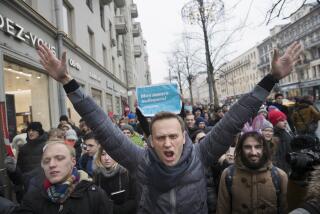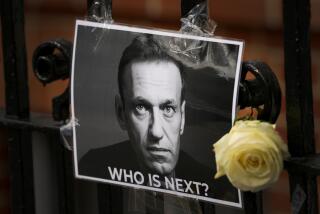Reborn Communists Gain Ground in Russia : Politics: Two years ago, they were banned. But the New Reds have more adherents than any other faction.
- Share via
MOSCOW — Boris N. Yeltsin was dead wrong.
Addressing the U.S. Congress on a June, 1992, visit to Washington, the Russian president declared: “The world can sigh in relief; the idol of communism--which spread social strife, enmity and unparalleled brutality everywhere, which instilled fear in humanity--has collapsed. . . . I am here to assure you: We shall not let it rise again in our land!”
Two years after Soviet Communist hard-liners tried but failed to seize control of the Kremlin, two years after Russia’s president banned Communist activities on Russian soil, the Reds again are the biggest organized political force in the land.
“Communism can’t be buried, any more than all humankind can be buried,” Yegor K. Ligachev, a longstanding enemy of Yeltsin’s and the No. 1 conservative on the old Soviet Politburo, said happily.
Yuri Tsourebashvili is living proof.
Every afternoon, the 29-year-old former teacher stands on the steps of Moscow’s V. I. Lenin Museum, a Stalin button on his breast, hawking postcards of Lenin and copies of Molniya (Lightning), the organ of the Russian Communist Workers Party, just one of at least a dozen parties that now claim to be waging Marxist class struggle in Russia.
Asked why he is a Communist, the native of the Caucasus Mountains shook his close-cropped head and replied: “In Russia, in the Soviet Union, everything has broken down. We used to be first in arts, in sports, in everything. . . .”
“That’s right, you tell him, young man,” chimed in an elderly woman who was eavesdropping.
Another man outside the museum, a rallying point for anti-Yeltsin leafleteers, sidled up with a well-thumbed Bible and announced that Jesus Christ too was a Communist: “Read Acts 4:32.”
Undeniably, Russia’s Communists today include many confused old folks, impoverished victims of market reform, incorrigible Soviet imperialists and plain crackpots. But with Yeltsin threatening to call early elections this autumn, the New Reds can hardly be dismissed, because they also boast the country’s biggest parties and are schooled in ruthless Leninist principles of political combat.
In the main, the neo-Communists are also steered by a different breed than the career bureaucrats who rose to the apex of the old Communist Party of the Soviet Union, a body that became more like a Russian-speaking Chamber of Commerce than the underground army of yore.
In contrast, today’s leaders are gifted propagandists, like Gennady A. Zyuganov, chief ideologue for the Soviet-era party in Russia, or rabble-rousing orators like Moscow deputy Viktor I. Anpilov, both in their 40s.
With unblushing opportunism, Zyuganov, a former schoolteacher from the Russian countryside, has even allied his Communist Party of the Russian Federation with yesterday’s ideological foes--quasi-Nazis, monarchists and nationalist bigots included.
The resulting hybrid, the National Salvation Front, has been by far the most effective force at bringing anti-reform forces into Moscow’s streets. At Front rallies, Christian icons can be seen waving in the air alongside red flags, and appeals to Soviet inter-ethnic “brotherhood” can be heard mingled with anti-Semitic epithets.
(But only 3,000 to 4,000 Muscovites responded Friday to the call of a bewildering mishmash of anti-reform organizations, the Front among them, to stand for hours in a cold evening rain and shout their hatred of Yeltsin.)
Marxist purists might hold their noses at such pandering to the right, but Zyuganov’s tactics are merely a throwback to the Komintern’s “Popular Front” strategy of the 1930s. And Lenin himself was always wolfishly eager to forge alliances with non-Communist “useful idiots.”
On Nov. 6, 1991, Yeltsin delivered the last of a series of bans on the Russian and Soviet Communist parties, which he accused of wholesale complicity in the Aug. 19-21, 1991, attempted coup against Soviet President Mikhail S. Gorbachev and his reformist policies. But last November, Russia’s Constitutional Court partially lifted Yeltsin’s order, ruling that he had violated the constitution.
Although at least half a dozen post-Soviet parties had formed beforehand, the court’s watershed decision in defiance of Yeltsin was the real impetus for Russia’s neo-Communist movement. The birth, however, was humble.
At a boardinghouse overlooking a frozen reservoir north of Moscow, an “extraordinary congress” of more than 650 delegates from all over Russia assembled in February and voted to resume party activities.
Seven autograph-scribbling VIPs also came--members of the State Emergency Committee that had tried to depose Gorbachev.
The Communist Party of the Russian Federation was born. It was not just a resumption of the old apparat , because by a huge majority Zyuganov was elected chairman, not Valentin A. Kuptsov, the silver-haired and ineffective “partocrat” who was the last leader of Soviet-era Communists in Russia.
Today, Zyuganov’s party claims 600,000 members and is unquestionably the largest of Russia’s many parties. It has vowed to “work for Russia’s return to the road of socialist development.” It demands that the state guarantee the toiling masses a minimum of food and other goods. It insists on a halt to “capitalization.”
All that sounds tempting, given Russia’s economic and social turmoil, but Communists in Russia are not just any party. They are The Party that for nearly three-quarters of a century ran the world’s largest nation, spilling untold amounts of blood. Most Russians haven’t forgotten.
“In their years in power, the Communists committed so many crimes and evil deeds that they have become extremely unpopular,” noted Nikolai K. Svanidze, a political observer for Russian television. “They have nothing new to offer. . . .”
In fact, the real news may be that, of the 19 million card-carrying Communists who lived in the Soviet Union, Zyuganov has been able to enlist only a tiny fraction.
Svanidze said membership claims by the various Communist parties are wildly inflated anyway. He says he thinks that only half a million Russians at most are still professed Communists.
People who can make their way in today’s Russia have bailed out of communism, Svanidze added, and those who are left, even if they number in the hundreds of thousands, are very often old people whose only political activity is to sit at home and reminisce.
For most Soviet citizens, Communist Party membership wasn’t a matter of conviction--it was a social obligation or a deft career move.
Another problem for neo-Communists is that, in keeping with leftist tradition, they find unity elusive. Some of the dozen or so parties loudly claiming the Marxist-Leninist mantle are so small that their members could all fit into a Moscow apartment.
In one low-flying episode from neo-Communist history, a desperate Anpilov, whose Russian Communist Workers Party is a rival to Zyuganov’s party, tried to lure delegates from the February congress at the Klyazma reservoir into his fold by promising them a bigger hall and free lodging.
Yet another party claiming a Marxist pedigree is headed by Vice President Alexander V. Rutskoi.
“If the left-wing forces were united, the curbing of the (Yeltsin) regime would be a matter of one week,” Zyuganov, a ruddy-faced man who looks furiously intense even when he is chatting calmly to a journalist, grumbled this summer.
The Communists’ main quandary these days is the old question posed by Lenin in his famous tract “Chto Delat”-- “What Is to Be Done?” Zyuganov’s group, which inherited most of the old apparatchiks still active in left-wing politics, plus the bulk of the Communist votes in Parliament, says it intends to come to power by legal means.
Anpilov’s tactics and wild-eyed rhetoric are starkly different.
“We don’t have guns yet, but we will, and pretty soon too, I assure you,” the former television foreign correspondent assured his followers this year.
On May Day, when an anti-Yeltsin demonstration degenerated into a riot that left one policeman dead, Anpilov was present, haranguing the faithful from the back of a flatbed truck, as is his habit. The violent clash in Moscow marked the first appearance of gangs of organized anti-Yeltsin toughs, who took riot police completely by surprise, and Anpilov’s role in the incident is still a matter of debate.
Speaking in an interview earlier this month, Ligachev said that with the likelihood of early elections, the “first goal” of Zyuganov’s party will be to form a “popular bloc of social and patriotic forces.” Its campaign platform, he said: protection of the soviets, or local elected councils, that Yeltsin wants to replace; public ownership of industry, and voluntary reconstitution of the Soviet Union.
“Communists are now at the stage of gathering and husbanding their forces,” said Ligachev, 72. “Frankly, Yeltsin’s policies help us a lot. . . . He revolutionizes the masses, educates them politically, pushes them to destroy the regime he heads.”
Even Ligachev, Yeltsin’s old nemesis inside the Soviet party, has had a political rebirth. He now serves on a board that oversees a “union” of Communist parties in nine former Soviet republics, including the Communist Party of the Russian Federation.
But so far it is not clear who, in Leninist terms, might be the “useful idiot” in an electoral alliance entered into by Communists. The moderate opposition Civic Union, composed of an industrial and managerial elite that many observers see as an alternative government, has shunned overtures from Zyuganov’s party.
Many observers think that any danger of dictatorship in Russia comes not from the Communists but from their partners in the anti-Yeltsin coalition: the ultranationalist right. If they take power, “Communists will get only crumbs from the pie of power,” Svanidze predicted.
And dreams at the top of the Communist Party of the Russian Federation for a durable anti-Yeltsin alliance with the extreme right may have disintegrated when influential Russian nationalist lawmakers Sergei N. Baburin and Nikolai Pavlov quit as co-chairmen of the Salvation Front last month.
Andrei S. Grachev, an incisive political onlooker who once worked in the Soviet party’s now-defunct Central Committee, is dismissive of Communists’ chances for returning to power. He says their by-rote application of old Leninist formulas--forming party-dominated “fronts,” betting on workers’ disenchantment to trigger nationwide strikes that could bring down the government--is a sign of political bankruptcy.
“You’ve heard of the infantile malady of communism?” Grachev asked with a smile, referring to another celebrated tract by Lenin. “Today, we have its senile malady.”
Communism’s Successors
Main players among the groups succeeding the old Communists:
* Communist Party of the Russian Federation--Claims 600,000 members. Chairman: Gennady A. Zyuganov. Inherited most Communist “partocrats” who remain in left-wing politics, including avuncular head of Soviet-era Russian party, Valentin A. Kuptsov, and legislators in Communist parliamentary bloc. Zyuganov, talented polemicist and cunning strategist, is co-chairman of National Salvation Front, an anti-reform coalition that has fused Communists with erstwhile ideological enemies like Russian ultranationalists, Constitutional Democrats and fascists.
* Russian Communist Workers Party--Also claims 600,000 members. Leader: Viktor I. Anpilov. On extreme left fringes of Marxist movement, stressing need for direct action to oust Russia’s leadership, vs. Zyuganov’s emphasis on taking control of the Kremlin by constitutional means.
* Socialist Workers Party--Claims 10,000 members. Founders include Marxist historian Roy A. Medvedev and cosmonaut Vitaly Sevastyanov. Sees itself as left-wing of Western European-style social democracy, trying to blend its philosophy with communism. Claims 50 regional organizations, but was probably biggest victim of creation of Zyuganov-led party. SWP membership has since dropped by 90%.
* All-Union Communist Party of Bolsheviks--Membership unknown. General Secretary Nina Andreyeva, a St. Peterburg chemistry teacher, is now leader of Russia’s neo-Stalinists. Her party rejects ideal of Western-style democratization of Russia, but is riven by internal disputes.
* People’s Party of Free Russia--Claims 60,000 members. Leader: Vice President Alexander V. Rutskoi. Founded by Rutskoi and other pro-reform Communists in the putsch month of August, 1991. Goal is not a new ideology, but solution of concrete tasks. It sees its clientele as white-collar, salaried workers and socially conscious entrepreneurs.
* Minor players: Other small to minute Communist groups include: Democratic Workers Party (Marxist), Communist (New Approach) Party of Labor, Russian Party of Communists and Marxist Workers Party-Party of the Dictatorship of the Proletariat.
Sources: Itar-Tass News Agency, Times staff
More to Read
Sign up for Essential California
The most important California stories and recommendations in your inbox every morning.
You may occasionally receive promotional content from the Los Angeles Times.










